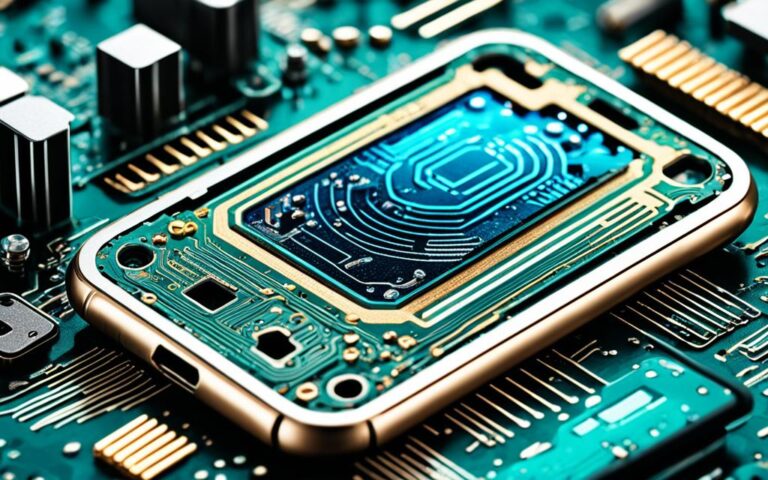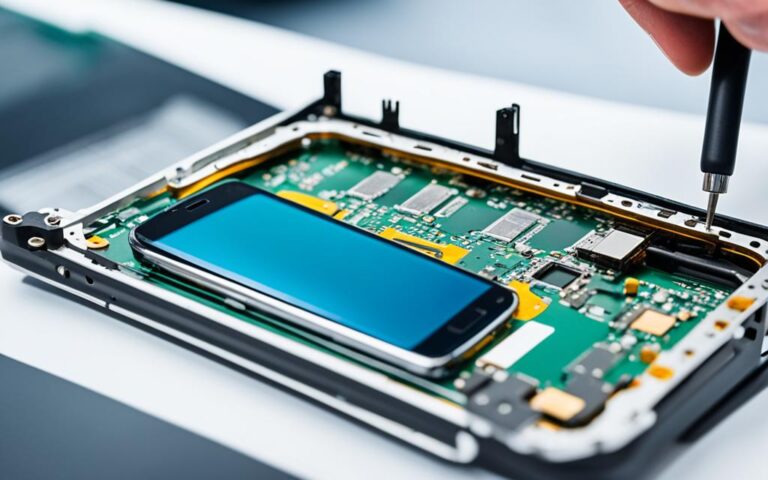The Future of Phone Repairs: What to Expect
The Future of Phone Repairs is an evolving landscape shaped by technological advancements, consumer preferences, and legislative changes. As smartphones become increasingly integral to our daily lives, the repair industry is undergoing significant transformations to meet new challenges and opportunities. This article delves into the Phone Repair Trends that are setting the stage for what you can expect in the coming years, from the rise of the Right to Repair Movement to the growing focus on sustainability and repairability.
Technological Advancements in Phone Repairs
AI and Machine Learning
Artificial Intelligence (AI) and machine learning are revolutionizing the diagnostic process in phone repairs. These technologies can analyze vast amounts of data to identify issues with pinpoint accuracy. For example, AI algorithms can predict battery failures or screen issues based on usage patterns, thereby allowing for preventative maintenance. This level of precision minimizes the margin for error, ensuring that the root cause of a problem is addressed.
3D Printing
The advent of 3D printing technology is a game-changer for the Future of Phone Repairs. Repair shops no longer have to rely on a supply chain for specific components. With 3D printers, they can create the necessary parts on-demand, reducing wait times and making the repair process more efficient. This technology is particularly beneficial for older models, where parts may be scarce.
Augmented Reality (AR) Assistance
Augmented Reality (AR) is another technological innovation making waves in the repair industry. Technicians can use AR glasses or apps to overlay digital information, such as repair guides or schematics, onto the physical world. This tool aids in complex repairs, providing real-time guidance and reducing the likelihood of mistakes.
Consumer Preferences: The Shift Towards Repairability
As awareness about sustainability grows, consumers are increasingly looking for devices that are not just advanced but also repairable. This shift in consumer preferences is prompting manufacturers to design phones with repairability in mind, a trend further explored in this Fixsmart Niddrie article.
Right to Repair Movement
The Right to Repair Movement is gaining significant traction, especially in the United States and Europe. Advocacy groups are pushing for legislation that allows consumers the freedom to choose where they get their devices repaired, whether it’s through the manufacturer or a third-party service. This not only makes repairs more accessible but also promotes competition, which can lead to better service and lower prices.
Modular Smartphones
The concept of modular smartphones is not new but is gaining renewed interest. Companies like Fairphone are leading the way in creating smartphones with interchangeable parts. This design allows users to easily swap out a faulty camera, battery, or even a screen, extending the device’s lifespan and reducing electronic waste.
Transparency in Repair Costs
In response to consumer demand for transparency in repair costs, some companies are adopting standardized pricing models for common repairs. Apple, for instance, has a detailed pricing list for various iPhone repairs. This level of transparency eliminates the guesswork in repair costs, allowing consumers to make more informed decisions.
Eco-Friendly Repair Options
Another emerging trend is the availability of eco-friendly repair options. Some repair shops are now offering services that use recycled or sustainable materials, further reducing the environmental impact of phone repairs.
Environmental Legislation
Another aspect that is increasingly coming into focus is environmental legislation. Governments are looking at the repair industry as a way to reduce electronic waste. By encouraging repairs over replacements, these laws aim to minimize the environmental impact of discarded devices.
Legislation and Industry Standards
As the Future of Phone Repairs continues to evolve, the role of legislation and industry standards is becoming increasingly critical. These frameworks aim to regulate the repair industry, ensuring both quality and consumer safety, while also addressing environmental concerns.
Standardized Repair Protocols
Standardized repair protocols are being developed to maintain a high level of quality and safety across the industry. These guidelines outline the best practices for various types of repairs, from screen replacements to software troubleshooting. By adhering to these protocols, repair shops can ensure they are providing services that meet or exceed industry standards. Organizations like the International Electronics Manufacturing Initiative (iNEMI) are working on creating these standardized protocols.
Certification Programs
Certification programs for repair technicians are becoming more prevalent. These programs, often offered by device manufacturers or independent organizations, aim to ensure that technicians have the necessary skills and knowledge to perform repairs effectively and safely. Certified technicians are usually more trusted by consumers and are often required for warranty-covered repairs. Some programs even offer specialized training in areas like data recovery and cybersecurity.
Government Regulations
Government regulations are also shaping the industry, especially in the context of the growing Right to Repair Movement. This consumer rights movement is advocating for laws that allow consumers the freedom to repair their devices using third-party services without voiding warranties. Such laws are already in place in some jurisdictions and are under consideration in others, making repairs more accessible and affordable for the general public.
Environmental Legislation
Another aspect that is increasingly coming into focus is environmental legislation. Governments are looking at the repair industry as a way to reduce electronic waste. By encouraging repairs over replacements, these laws aim to minimize the environmental impact of discarded devices. Some countries are even offering tax incentives to repair shops that adhere to eco-friendly practices.
The Impact on Repair Shops
The Future of Phone Repairs is not just shaping consumer behavior and manufacturer policies; it’s also having a profound impact on repair shops. These businesses are at the frontline of implementing new technologies, adhering to legislation, and meeting evolving consumer demands. As part of the emerging Phone Repair Trends, here’s a closer look at how repair shops are adapting.
Investment in Advanced Tools
To keep pace with technological advancements, repair shops are making significant investments in advanced tools and equipment. This trend is a key part of the Phone Repair Trends that are shaping the industry. It includes not just hardware like high-precision screwdrivers and soldering stations, but also specialized software for diagnostics. These tools enable technicians to perform complex repairs that were previously not possible, thereby expanding the range of services offered.
Training and Skill Development
As smartphones become more complex, the need for skilled technicians is growing. Many repair shops are encouraging their staff to undergo rigorous training and obtain certifications from recognized institutions. This skill development ensures that technicians are up-to-date with the latest repair methodologies and are competent in handling a variety of issues, from hardware malfunctions to software glitches.
Sustainability Practices
In line with global sustainability goals, repair shops are also adopting eco-friendly practices. This is another aspect of Phone Repair Trends that is gaining importance. It includes offering repair services that use recycled or sustainable materials, as well as responsibly disposing of waste. These practices not only appeal to environmentally conscious consumers but also contribute to reducing the industry’s overall carbon footprint.
Customer Education
An emerging trend in the repair industry is customer education. Repair shops are increasingly taking the initiative to educate customers on proper device maintenance and care. By offering workshops or informational materials, they aim to reduce the frequency of avoidable repairs, thereby promoting a culture of responsible device usage.
The Role of Manufacturers
Manufacturers are also playing a pivotal role in shaping the Future of Phone Repairs. From offering extended warranties to developing repair-friendly designs, manufacturers are increasingly recognizing the importance of repairability in their devices.
Extended Warranties and Repair Programs
Many manufacturers are now offering extended warranties and specialized repair programs. These initiatives aim to provide consumers with more options for repairing their devices, thereby increasing brand loyalty and reducing electronic waste. Some companies even offer trade-in programs, where consumers can exchange their old phones for newer models at a discounted price, ensuring that the old devices are recycled or refurbished.
Repair-Friendly Designs
Some manufacturers are moving towards repair-friendly designs that make it easier for technicians to access internal components. This is a win-win situation for both consumers and the repair industry, as it reduces the time and complexity involved in repairs. Companies like Fairphone are pioneering this approach, offering modular designs that allow for easy component replacement.
Software Support
Long-term software support is another area where manufacturers can make a significant impact. By providing software updates for older devices, they can extend the lifespan of a phone, reducing the need for frequent replacements. This is particularly important as consumers become more conscious of the environmental impact of their choices.
Environmental Impact
Manufacturers are also becoming more conscious of the environmental impact of their products. By designing phones that are easier to repair, they contribute to sustainability and waste reduction. For more information on how environmental legislation is affecting the repair industry, you can refer to this UK Parliament report.
Collaboration with Repair Shops
An emerging trend is the collaboration between manufacturers and repair shops. Some manufacturers are partnering with certified repair shops to offer official repair services. This ensures that consumers have access to high-quality repairs that meet the manufacturer’s standards.
Phone Repair Trends: Frequently Asked Questions (FAQ)
What is the Right to Repair Movement?
The Right to Repair Movement is a consumer advocacy initiative that pushes for legislation allowing consumers to repair their devices using third-party services without voiding the manufacturer’s warranty.
How are manufacturers contributing to repairability?
Manufacturers are increasingly focusing on creating repair-friendly designs and offering extended warranties. Some are even collaborating with certified repair shops to provide high-quality repair services.
What are standardized repair protocols?
Standardized repair protocols are guidelines developed by industry organizations to ensure a high level of quality and safety in phone repairs. These protocols outline best practices for various types of repairs, from screen replacements to software troubleshooting.
How is environmental legislation affecting phone repairs?
Environmental legislation aims to reduce electronic waste by encouraging repairs over replacements. Some countries offer tax incentives to repair shops that adhere to eco-friendly practices.
What is the role of certification programs in phone repairs?
Certification programs ensure that repair technicians have the necessary skills and knowledge to perform repairs effectively and safely. These programs are often offered by device manufacturers or independent organizations.
Conclusion
The Future of Phone Repairs is an evolving landscape that is being shaped by a multitude of factors, from technological advancements to legislative changes. As we’ve explored, Phone Repair Trends are influencing not just consumers and manufacturers, but also the repair shops that serve as the backbone of the industry. These trends encompass everything from investment in advanced tools and skill development to a growing focus on sustainability and customer education.
As smartphones continue to become more integral to our daily lives, understanding these trends is crucial for both consumers and industry professionals. Whether it’s the push for more sustainable practices or the adoption of new technologies, the future promises a more efficient, eco-friendly, and consumer-centric approach to phone repairs.
By staying informed and adapting to these changes, we can all contribute to a more sustainable and efficient future for phone repairs.












